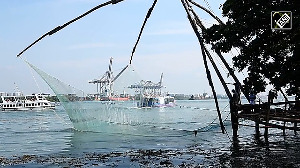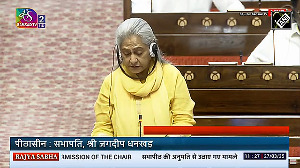The 1962 conflict with China was a painful military debacle, but it must be stressed that one can learn more from a defeat.
The problem in India has been that we are in the first place not even ready to acknowledge our history, thus making sure that we do not learn from it, says Colonel Anil A Athale (retd) on the day one of the Indian Army's famous batallions lost an uneven battle 50 years ago.
Many intelligent readers have questioned the recent spate of articles on the 1962 Sino-Indian border conflict (please note 'border conflict' and NOT war). Even a former Indian Air Force chief spoke in the same vein and asked us all to 'move on'.
It is true that 1962 was a painful military debacle, but it must be stressed that one can learn more from a defeat. The problem in India has been that we are in the first place not even ready to acknowledge our history, thus making sure that we do not learn from it.
At another level, the 'mindset' that brought us grief still continues to haunt us. The characteristics of this mindset are wishful thinking about threats, lack of coordination between various arms and government departments, disconnect between situation on the border and hinterland and the military and political leadership and finally a fond hope that we can wage a 'peaceful war' and protect ourselves from aggression.
The controversy over the non-use of offensive air power is one such indicator. When the air chief recently mentioned that had we used air power in 1962 we could have had the better of the Chinese, he was immediately hauled over the coals by the usual suspects of the Dilli Darbar. Such is the fear of the truth of leadership failures being exposed!
The irony is that the air chief did not say anything new. The analysis of the non-use of air power by India in 1962 has been circulated within the military since 1988. In 2003, when the official history was uploaded on the Internet, this has been in the public domain. The facts speak for themselves.
In 1962, though the Chinese air force was thrice the size of the Indian Air Force, the bulk of the Chinese air force was located to deal with the Taiwan threat. In addition, the Chinese had anti-aircraft resources or radars in Tibet. In the north opposite Ladakh, China had two airfields, Khotan and Kashgar. In the east there were four airfields: Jaykundo, Chamdo, Nachu and Kuming.
All the Chinese airfields were located at altitudes of 9,000 feet or higher. It meant that the Chinese aircraft could not take off with full loads. On the other hand, the IAF had several air strips in the vicinity, thanks to World War II. Also, the IAF's Hunter and Mystere aircraft were superior to the Chinese MiG-17s and 19s.
The only aircraft that could reach the targets in India was the Illushin-28 bomber with barely 48 tonnes of bomb loads. The IAF could deliver 144 tonnes of bomb load daily with fighters and 192 with Canberra bombers.
Thus, the IAF was seven times stronger than its Chinese counterpart. The IAF could have easily disrupted the long Chinese supply lines. In Ladakh, it could have neutralised the Chinese advantage in guns.
But crucially, since China was not able to use its air force, seeing our own air force dominate the skies would have had a very beneficial effect on the morale of the ground troops. All military analysts agree that on the Arunachal front, more than the Chinese strength, it was the loss of morale that led to the military debacle.
But the clinching evidence on this issue is the Chinese action -- or lack of it. China scrupulously avoided interfering with IAF supply missions so as to not give the IAF an excuse to use its fighter air power. In addition, despite severe problems of supply to its troops on the Arunachal front, China never used its air force. It is to be noted that in 1950 when it moved to occupy Tibet, China had used its air power.
The IAF failed to carry out any professional assessment of the situation. In fact, the whole war was being run by Lieutenant General B M Kaul.
The air chief was not in the decision-making loop and used to know about the conflict from newspapers. The IAF's chief of planning, in an interview with our team, told us that air power use was not recommended as 'that would have turned world public opinion against us.'
A stranger argument for a military decision is difficult to find. Defence Minister V K Krishna Menon was in favour of the use of air force, but was checkmated by the fear of 'escalation.'
In a bizarre situation, symptomatic of those times, the head of the Congress party in Bengal directly approached the American ambassador and sought an American air umbrella to protect Kolkata, that was incidentally out of range of the Chinese aircraft.
India had obviously not learnt the lesson that in 1947 Kashmir was saved from Pakistani raiders mainly due to the use of air power that destroyed their vehicles and supplies.
We did not draw any lessons from the 1947 Kashmir conflict since the comprehensive history of the 1947 Jammu and Kashmir operations, prepared by the ministry of defence, was published only in 1987, a full 40 years after the event.
But it is unfair to blame the IAF alone for the unprofessional approach. Symptomatic of the way the border war was conducted is exemplified by the way army units were moved and flung into battle.
Major K P P Nair (later, a lieutenant colonel) was a senior company commander of an infantry battalion that had liberated Goa in December 1961. His battalion was located in Panaji and Ponda in Goa. On October 4, 1962, the commanding officer was posted out to Tezpur and the battalion placed on alert to move to the Arunachal front. The new commanding officer was ordered to join the battalion in Tezpur.
On October 8, the battalion was ordered to move to Tezpur. There was no transport available, so the officers took over mining tipper trucks at gun point and moved the men to Belgaum.
As the battalion moved on its way to the border via Pune, Nair recalled that the army commander in Pune advised him to carry ceremonial dress and lounge suits since there would be many occasions to socialise with the tea garden people. After a gauge change and a long train journey, the troops reached Misamari on October 21.
Since the transport was limited, heavy baggage was carried on the vehicles while the men marched by night and rested by day. After six days of marching, the battalion reached Bomdila, 134 kms away.
In a sign of the times, while at Chako, Nair bumped into another battalion similarly marching towards the front. Except that it was being led by a second lieutenant (the junior-most ranking officer in the army) since other senior officers had gone ahead in vehicles. At the young officer's request, Nair took charge of that battalion as well.
On October 27, the battalion was asked to prepare defences at Bomdila. But the very next day, the orders were changed and they were asked to move to Dirang. Here, one company (around 120 soldiers) was detached and sent to defend the divisional headquarters in Dirang. Here, the battalion was further spilt up into two and one company was sent to the west towards the Bhutan border.
On November 9, reports were received of some Chinese movement east of the Sela Pass. So Nair with one company was asked to move to a mountain feature called Nykmadung along a track that ran parallel to the Dirang-Sela-Towang road. Such was the lack of trust that a brigadier, who was present, suggested to Major Nair that he should get these orders in writing!
At the same time, another battalion defending the Sela pass was asked to move south and 'trap' the Chinese column. When Nair asked about the likely strength of the Chinese, he was told the commander had no information.
On November 10, Nair with around 120 soldiers left for Nykmadung. He was given an artillery officer despite the fact that the area was out of gun range. To cap it, the officer was a greenhorn, not even trained to control artillery fire.
On the night of November 14/15, Nair was asked to send a platoon to intercept the Chinese. This platoon, without the support of any heavy weapons, was ambushed by a far superior Chinese force and wiped out.
While this action was in progress, a party was organised at Dirang to celebrate the battalion's victory in the 1947 Kashmir conflict. The general himself was in attendance. While Nair was desperately trying to figure out how to retrieve his platoon, he received a telephone call from the battalion adjutant that Nair had to give a written explanation why he had failed to buy a ceremonial sword!
Apparently, General Pran Nath Thapar, the then army chief, had issued an order that all officers would be in possession of a ceremonial sword by a given date!
In the meanwhile, the Chinese had penetrated Indian radio communication and were passing on confusing orders. On November 19, Major Nair lost all contact with the battalion. He could see Chinese troops in large strength moving all over the area. Nair then took the decision to leave the main road and move east towards the foothills.
The men had no food, no warm clothing and reaching Chako was an ordeal. But Nair's company reached the rear with their weapons and in good order.
The bulk of the famous 'Red Eagle' Fourth Indian Division (that had won laurels in Italy and North Africa in the Second World War) disintegrated. Men ran back as individuals and an army turned into a rabble.
Nair's narrative explains the 'mystery' of the Indian Army's debacle in Arunachal Pradesh in 1962. Troops were moved without adequate familiarisation to unknown terrain. The officers had taken this to be another 'police action', like in Goa or Hyderabad. The Indian Army's leadership was following the strategy and tactics it used successfully against the 'Tribal Laskhar' in the Kashmir campaign of 1947.
Units occupying defences were sent on wild goose chases with inadequate support and with very little information about the enemy.
On the other hand, there was the Chinese army that had seen action in Korea. The Chinese army in that campaign showed how it could move large forces on foot. The Chinese nearly pushed the Americans into the sea in Korea using these very tactics.
The Indian Army's failure was due to unimaginative and soft leadership that had no clue how to fight a major war against a well-trained enemy. While then prime minister Jawaharlal Nehru and Menon are rightly blamed for strategic blunders and policy mistakes, the Indian Army cannot shy away from accepting a major portion of the blame for the debacle in Arunachal Pradesh.
The interview with Lieutenant Colonel K P P Nair was conducted in Bangalore on June 21, 1987.
Must See: Remembering a War






 © 2025
© 2025